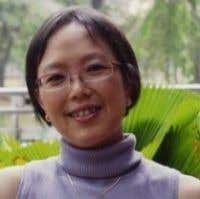Cher Lim (left) is a wine writer and has a fine-wine sourcing company in Singapore. She gained a Master's degree in Wine Technology, Management and Marketing at the University of Melbourne & Monash University in 2007 and is currently studying for the Master of Wine qualification. Her article also appears in Chinese via the Chinese flag on the right.
For some wine lovers, blind tasting is a kind of social game. Acing it in front of friends will, they hope, transform their reputation, making them seen as a first-class wine connoisseur with amazing knowledge and palate memory. For wine professionals, though, blind tasting is more than a game. It is a preferred regime in judging the quality of a wine since it is true that a preconceived idea imposed by a celebrated label can have an impact on the outcome of a judgement. So, judge the wine, not the label and the only way to do so is to taste it blind.
This is also the premise upon which the Grand Jury Européen (GJE) tasting is based, together with its unique scoring system. Much has been said about scoring systems for wine. Indeed many believers buy on the basis of scores, thereby creating an aura or cult status around the famous wine critics. I was therefore intrigued enough to find out more about the GJE system, which is supposedly more objective (being based on a panel rather than an individual taster) and scientific (with the use of a mathematical model). I had this great opportunity when a GJE tasting session was held in Singapore last month as part of the World Gourmet Summit food and wine festival. I must say that the other compelling reason to participate was having the chance to taste a total of 27 wines from Bordeaux's 2005 vintage, among them a number of mouthwatering ones that had already caught my attention.
GJE was founded in 1996 by François Mauss with the aim of providing an alternative way to classify wines. The members come from different parts of Europe and America, and are mainly professional tasters, sommeliers, producers and wine lovers. There are 35 permanent members of the GJE and each year at least 15 of them will be assembled to conduct a blind tasting of not more than 34 wines per day. The order of wines is randomly assigned, so the tasters are not to assume that the order is of increasing quality. Based on the GJE scoring system, each member will assign a score (1-7) to the wine tasted and a final score is derived by the use of a mathematical model. The rationale behind this approach is that it is not possible for 15 people to make the same error on the same wine at the same time.
Back to the event in Singapore, the objective of the exercise was to let participants, typically wine lovers of varying degrees, get the experience of a GJE-style tasting involving wines including Châteaux Mouton Rothschild and Haut-Brion as well as some lesser-known names. As the order is random, this is known as semi-blind format. The objective is not to identify the origin of the wine but to judge its quality purely from the glass. Since this is an entirely democratic process amongst the 50 or so participants, the outcome can be just as surprising as any presidential election known in history.
Wines were served in five flights, each of which comprised five to six wines. After each flight, participants, including the GJE panel, were asked to indicate by the raising of their hands, the score they assigned. As this was an informal, educational session, there was to be no recording or real tabulation of scores.
So, we should perhaps not be surprised that the two first growths did not turn out well in this tasting. Based on my observations, two wines seemed to have scored well among the participants – Châteaux Pavie and Cos d'Estournel 2005. I have to say that the sequencing of the wines tasted may well have played a part in this outcome. Specifically, some powerful wines and more delicate wines were tasted back to back in some flights by chance. Therefore, it would have been possible that the more delicate wine was overshadowed on the palate of the average enthusiasts, and I suspect even wine professionals. As the GJE expert panel also indicated their vote through the show of hands, it would not be surprising for some participants to be somewhat influenced by them. However, overall the session was fun and educational. It is to be hoped that the participants do not take the scores too seriously. Otherwise, the very fine and elegant Château Haut-Brion would be innocently missed by the jury!
